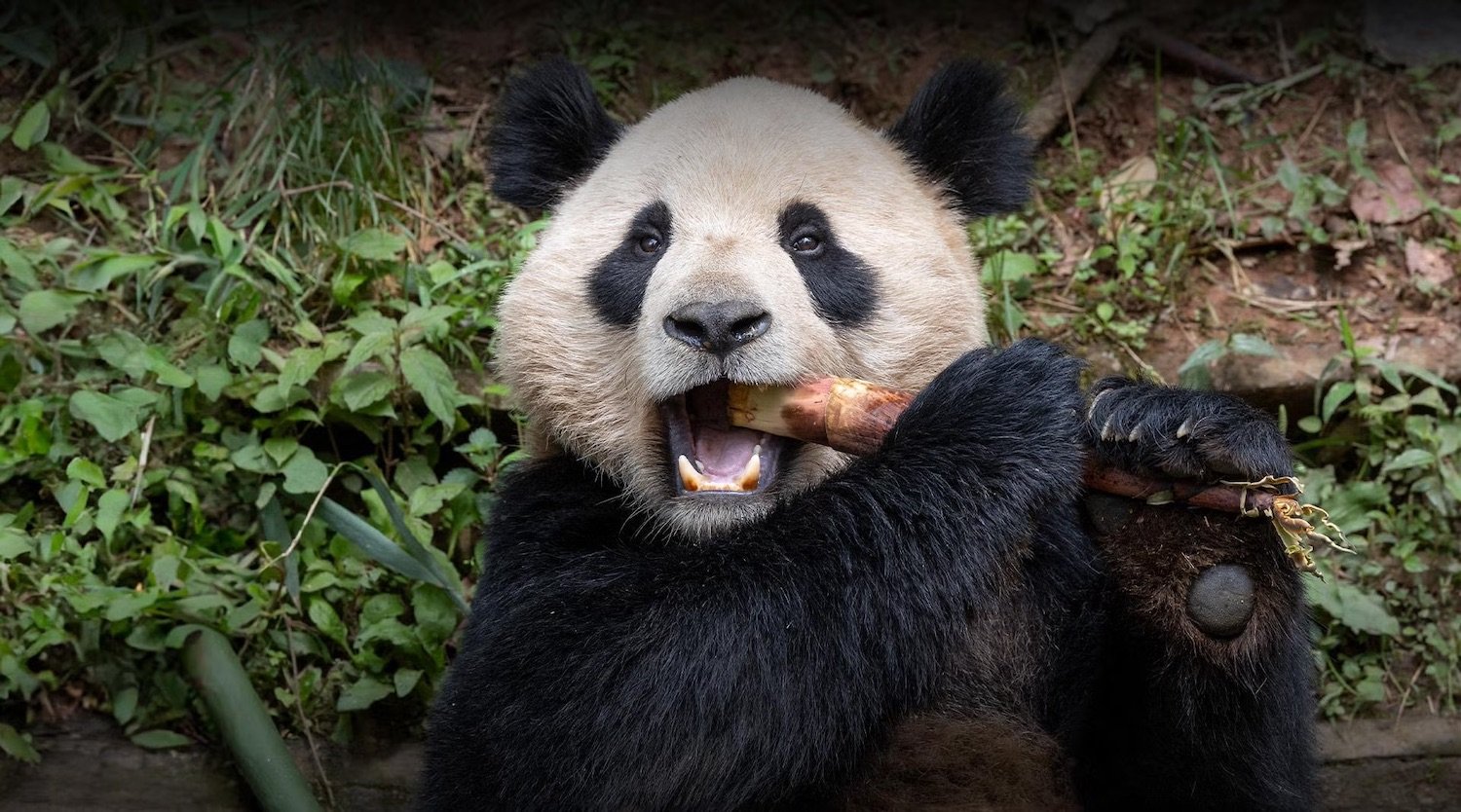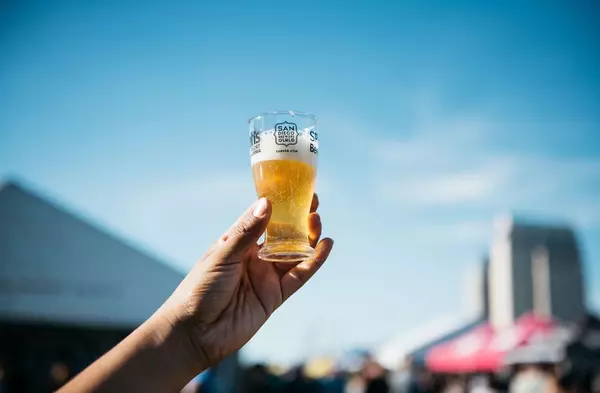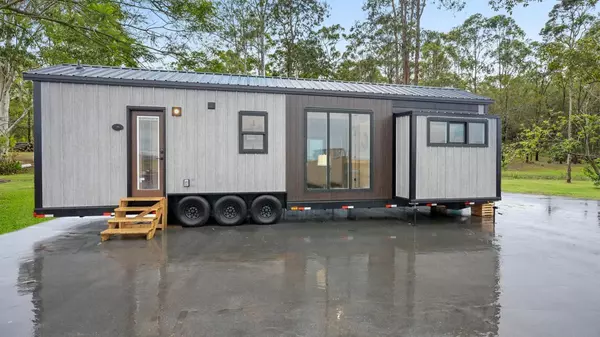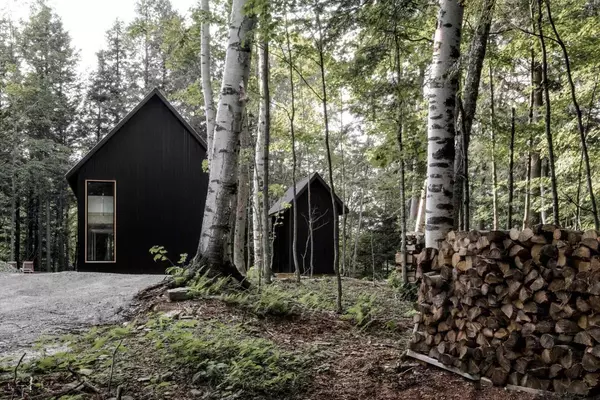How to Feed a Panda: Inside the Zoo’s Bamboo Buffet
Xin Bao, the San Diego Zoo’s four-year-old female panda bear, is tearing at bamboo culms, the hollow stalks that make up the plant, swallowing and going back for more while the splintered detritus collects on her fuzzy belly. In the enclosure next door, Yun Chuan, the five-year-old male, lies in repose against a wooden platform, chomping bamboo leaves. These pandas consume 30 kilos of the stuff each per day. That’s roughly 70 pounds. 140 together. 980 a week. Close to 50,000 pounds a year.
But you can’t Amazon 25 tons of bamboo or buy it from Target. It must be carefully cultivated. In fact, having an ample bamboo supply is one of the many stipulations the Chinese have for lending out their giant pandas to other countries, a practice known as panda diplomacy. Another is that the bears get AC if it’s over 85 degrees. One must also consider the height of the glass separating them from the humans, the shape of the rocks, the climbability of the trees, the amount of groundcover, the biosecurity of the panda food fridge.
There’s more, but my favorite is that panda “outputs” must be weighed daily (a measure of health!). Their “output”—a delicate name for what all that bamboo turns into—is around 12 kilos (26 pounds), the weight of around four average newborn humans. (Coincidentally, this list of demands is eerily similar to the one I make for my dogsitter.)

Four-year-old female panda Xin Bao snacks on bamboo, grown by the zoo.
San Diego checked off all these to-dos and more to welcome America’s first giant panda pair from China in 21 years, a significant sign of cultural bonds and diplomatic ties—both economic and environmental—between the two countries. “Working together with our international partners to protect this iconic wildlife species,” said Governor Gavin Newsom on the day of the pair’s public debut in August 2024, “we can achieve remarkable outcomes for conservation and cultural exchange, benefiting our communities and the planet.”
But all that feel-good stuff would not be possible without the bamboo—in the absence of this massive woody grass foundation, the tower of panda crumbles. There would be no live panda cams or “Welcome to Sunny Pan Diego” merch. For an example of how serious this rule is, the Calgary Zoo had to give back their pandas early when, during the pandemic, bamboo shipping failed.
San Diego, luckily, would never have that issue, because the zoo’s team started growing the crop themselves way back in 1996 as they prepped for the arrival of the current pair’s predecessors, Bai Yun and Shi Shi. That initial 10-year panda loan was extended to 22 years. “But we always knew they would go home,” says Nicki Boyd, the zoo’s curator of mammals. “[The Chinese] have a strong cultural belief that they want all pandas to pass on Chinese soil.”
San Diego planned to have more pandas after their departure, but it’s a logistical vortex that can take years to unspool—renegotiating the loan and conservation agreements; securing the moving permits; refurbishing the enclosure; and ironing out vital research priorities, like panda milk formula development and hearing studies. “This partnership isn’t just so people can see pandas,” Boyd says. “There is a significant effort to have positive conservation impacts.”
Now that we have our new panda duo, the bamboo program is once again blossoming. Figuratively. Actual bamboo blossoming is bad for pandas. More on that later.
The zoo invited San Diego Magazine for a special behind-the-scenes peek at what it takes to feed a panda, so I recently drove to the Safari Park in deep Escondido to meet up with Raj Brown, the director of horticulture, and Andres Guerrero, the horticulturist whose full-time job it is to cultivate panda meals.
The first thing Brown tells me is that giant pandas are considered “browsers,” a term for animals that primarily feed on high-growing leaves, soft shoots, and woody plants. They chew so much—up to 16 hours a day—that they have the strongest jaws out of all bears.
Instead of going through the Safari Park front gates as I’d expected, we hop into an SUV to check out the parking lot. Much of the bamboo, it turns out, grows in the magical grove that is overflow parking. “People don’t even notice it,” Brown says, pointing to the sea of cars.
In the SUV, we wind in and out of dirt thoroughfares. Between each is a mass of brilliant green bamboo stretching skyward. In all, six acres within the two parks are dedicated to bamboo, but this area alone holds at least 10 different varieties. “That’s the Phyllostachys vivax,” Guerrero says as we pass poles of feathery green foliage. “It’s one of their favorites—the big leaves and tender culms.”

Five-year-old male Yun Chuan eats a modest 35 or so pounds of bamboo per day.
The pandas eat four or five different varieties of bamboo every day. Each kind tastes slightly different and holds different nutritional values. These values also fluctuate throughout the year. The bears’ favorite bamboo, therefore, can differ from season to season, and the animal care team—like a parent trying to pass down healthy food habits—trusts them to select what their bodies need. “We provide options,” Guerrero says, “and they get to choose.”
We step out of the car and into the middle of a grove. Brown, looking up at the rustling leaves towering above, remarks on how peaceful it is. I, too, feel a sense of calm, like I’m in a place of deep purpose. All that surrounds me will soon be inside panda guts.
Guerrero tells me that, when he arrives each morning, he’s greeted by a text from the panda care team, placing an order. It’s something like, “30 culms of Bambusa vulgaris and 30 of the Phyllostachys aureosulcata.”
Translated to human, it’d be like, “The pizza isn’t moving, so send the grilled cheese and chicken nuggets.”
Guerrero will get out his hand saw, select each culm, and cut them one by one from the base. It’s tough work, like logging 60 small trees each day.
Then, he loads them up for delivery. If you see a white Ford F-250 long-bed truck driving south on the 805 with burlap over wisps of green, you are witnessing an incoming panda buffet.
Considering that the fastest-growing bamboo can gain 35 inches in a single day, keeping the pandas fat and happy seems pretty straightforward. Surely there can’t be any challenges, right? Wrong. According to Guerrero and Brown, bamboo flowers every 100 years or so.
To me, that initially sounds more like a beautiful sight than a big problem. But, “basically, after that happens,” Guerrero explains, “the whole crop dies.”
In the wild, these flowering events can cause pandas to starve to death.
The Safari Park team is unsure of the age of many of their bamboo plants, since they often come from cuttings that retain the age of the mother plant. “Our mission is to plot more bamboo, so we can compensate if that happens in the future,” Guerrero says.
As an extra safety net, they also have a contractual relationship with the San Diego Botanic Garden, which will supply fresh stalks in an emergency.
A few days later, I return to the zoo, where stanchions are lined up as far as the eye can see in order to contain the day’s mass of visitors. The bears munch away in their respective enclosures while Boyd, the mammal curator, tells me that Xin Bao had recently hit estrus—the three days of the year when a panda is fertile. During that time, she climbed up a tree and gazed out at Yun Chuan. “She was like a teenage girl looking at her first love,” Boyd recounts.
I think what she is really saying, though, is that, with any luck, Guerrero may have to up production soon.

Pandas in America: A Timeline
- 1936: The first panda brought to the United States, Su Lin, arrives in New York, captured on an expedition in China by American socialite Ruth Harkness.
- 1972: The US receives pandas Ling-Ling and Hsing-Hsing as a diplomatic gift following President Richard Nixon’s visit to China. They become residents of the National Zoo in Washington, DC.
- 1996: Bai Yun and Shi Shi are the first pandas to arrive at the San Diego Zoo as part of a 12-year conservation loan agreement with China.
- 1999: The San Diego Zoo becomes the first zoo in the world to capture a fetal panda on ultrasound.
- 1999: Hua Mei, born at the San Diego Zoo through artificial insemination of Bai Yun and Shi Shi, is the first panda cub to survive to adulthood in captivity in the US.
- 1999: Lun Lun and Yang Yang arrive at Zoo Atlanta and go on to have seven cubs before returning to China in 2024.
- 2000: China loans Mei Xiang and Tian Tian to the National Zoo, launching a $10 million research partnership on panda breeding.
- 2023: Le Le and Ya Ya arrive at the Memphis Zoo, making Memphis one of only four US zoos to have ever housed giant pandas (the others are San Diego, Atlanta, and the National Zoo). They returned to China in 2023.
- 2023: Bai Yun is paired with new mate Gao Gao after Shi Shi’s return to China.
- 2023: On August 19, Mei Sheng is born. He is Bai Yun and Gao Gao’s first cub and the second panda born at the San Diego Zoo; he moved to China at age 4.
- 2025–2012: Bai Yun and Gao Gao have four additional cubs: Su Lin (2005), Zhen Zhen (2007), Yun Zi (2009), and Xiao Liwu (2012).
- 2008: The original 12-year loan agreement is renewed, allowing pandas to remain in San Diego beyond 2008.
- 2013: A second renewal extends the conservation partnership, furthering breeding and research efforts at the San Diego Zoo.
- 2019: The last pandas at the San Diego Zoo return to China following the expiration of the 23-year conservation loan agreement.
- 2024: In February, the China Wildlife Conservation Association signs a 30-year agreement with the San Diego Zoo to renew panda conservation efforts, with plans for pandas to return to San Diego.
- 2024: On April 29, San Diego announces the return of pandas Xin Bao and Yun Chuan (son of Zhen Zhen), the first to enter the US from China in 21 years.
- 2024: On August 8, Xin Bao and Yun Chuan make their public debut in the newly expanded Panda Ridge at the San Diego Zoo, a habitat that mimics their native Sichuan environment.
The post How to Feed a Panda: Inside the Zoo’s Bamboo Buffet appeared first on San Diego Magazine.
Categories
Recent Posts










GET MORE INFORMATION




